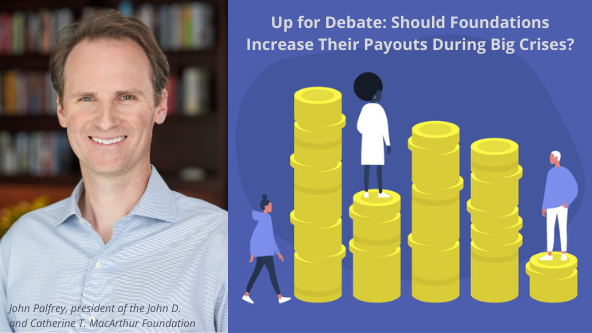
There’s an old saw that goes something like this: “an elite university is nothing more than a financial firm with a teaching and research operation attached.” This critique is not entirely fair. But neither is it without merit as a critique of the modern university with a large endowment.
The same could be said of many legacy foundations, especially those that have “perpetuity” built into their charters, as the John D. and Catherine T. MacArthur Foundation does. We manage a great deal of money and we operate a charitable effort with the proceeds. An important part of our job is the sound financial stewardship of a large endowment.

What’s helpful about this critique is that it forces a question about our principal mission as a large, legacy foundation: Is it to maintain a large investment portfolio or to grow that large investment portfolio even larger? Is it to do good in the world, in accordance with a set of agreed upon values, and a vision for how we can make a difference? When put this way, the answer is clear; we would all opt for some version of the latter.
Larry Kramer’s article, to which we respond, likewise provides a helpful prompt as to what our purpose is as foundations. While the MacArthur and Hewlett foundations have taken different approaches to spending during this year’s pandemic, Kramer makes many good points and provides a helpful frame for discussion. Most constructive to me is the idea that there is, in fact, a trade-off between expenditure of resources today and the potential to expend resources at a point in the future. This truth is inescapable.
If we spend more now, a legacy foundation such as MacArthur is likely—though not certain—to leave our successors less to spend to pursue a similar mission in the future. As we contemplate spending more to meet urgent needs, what troubles me is the requisite lack of humility in arguing for additional expenditure today compared to tomorrow. It seems to me inescapable that we thereby reason that current needs are as great, if not greater, than they will be in the future; or perhaps we reason that our ideas are as good, if not better, than the ideas of those who follow us. Either way, we center ourselves and our moment rather than the people and the times to come.
But it must also be true that there are in fact times when we—those of us with the power and resources that legacy foundations have—should do more, not less. This past year, 2020, is just such a year. The twin pandemics of COVID-19 and the vivid, systemic racism on display in the United States, brought into broad public consciousness needs that were new as well as heightened needs that have existed for far too long. We were called upon to stand up for the integrity of our democratic system in the midst of an historic US presidential election. Opportunities and challenges presented themselves at local, national, and global levels at a fevered pace throughout 2020.
MacArthur was among the foundations that responded to this unprecedented crisis by spending more than we planned in 2020. We did so by pulling two levers. First, we allowed our endowment draw to float higher than our spending guidelines, and the IRS minimum, called for. Second, we decided to issue “social bonds” in the amount of $125 million to make additional grants and investments in people, organizations, and communities. Our intention has been to respond to the crises of this moment without holding back the support we had planned to provide the grantees of our ongoing programs. As we embark on a new year, I think our staff and board would almost certainly make the same decision again (though we would likewise agree that no one wishes for a repeat of 2020 any time soon).
There are two ways in which this approach may shed light on Kramer’s article, which can be read at least in part as a critique of the issuance of social bonds or of spending at a higher rate than planned in 2020. Kramer cites a hypothetical case in which a higher level of bonds are issued by a foundation and repaid over a much longer period at an interest rate about twice the rate that the MacArthur Foundation is paying for the bonds we issued. In this hypothetical scenario a very different approach to repayment was also applied.
In MacArthur’s case, we are paying 1.299 percent on the $125 million in debt and setting aside up to $10 million per year to prepare for the repayment of this debt at the end of a 10-year term. When the bonds come due, we will have options: to roll over the debt, to pay it off with the funds that we have set aside (and which, since they have been re-invested in the endowment, likely will have grown), or to pay it off with other funds. I believe that this approach represents sound financial stewardship. We are taking advantage of historically low interest rates to be able to give out more money in a time of great need. One way of looking at it: we are leveraging our balance sheet to fund those who do not have the ability to raise such favorable debt—and who in turn will generate high social returns on the use of these funds.
So, yes, Kramer is surely right that there is some kind of a trade-off in making these grants of $125 million. But the trade-off is very modest. The low interest rate means that the debt service is under $2 million per year, which we are offsetting in part by lower administrative expenses in other areas. The $10 million we are setting aside each year will come from our annual endowment draw. And the 10-year repayment period means that we, or our successors, should not have a huge bill—or at least, various options—for managing the retirement of the debt in the not-too-distant future.
These are the costs of issuing the debt. The benefits are much greater. We believe that the opportunities to address racial and ethnic inequities, the immediate risks associated with the 2020 election, and basics such as food insecurity in a heightened moment of acute need are such that the added funds have been well-spent.
We have also sought to seize particular opportunities that have never before presented themselves. For many years, the MacArthur Foundation has emphasized reform of the criminal justice system. The goal of this work is to reduce the jail population and racial and ethnic disparities in our justice system. In 2020, during the pandemic, jail populations (though not disparities, by and large) dropped in dramatic ways. It made sense for us to deepen our investment to ensure that this accelerated pace of reform is not just the norm but leads to lasting change. The beauty of our approach is that it has allowed us to fund both existing grantees through our regular programs as well as new movement-building efforts such as the Democracy Frontlines Fund, a participatory grantmaking process designed to support leaders of color advocating for equitable change. We join Kramer and the Hewlett Foundation as a supporter of this effort.
Innovation, creativity, and bold ideas often emerge in crisis. MacArthur has three overarching goals with our $125 million in social bonds: hastening an equitable recovery; seizing the opportunity to create lasting transformation; and helping reimagine what is possible for communities and organizations. We are being intentional in our approach by seeking input from the communities we aim to support. Taking lessons from our early experiences with participatory grantmaking, we have convened an advisory group to help guide this work, made up of leaders and communities most impacted by systemic racial inequality and by the pandemic.
Leaders in philanthropy and critics of our field are engaged in a worthy conversation about how and when to spend more money. The terrible confluence of events in 2020 should serve as a useful object lesson. I believe that the end result of this necessary self-examination should be a quite different approach.
Philanthropies should not operate like universities that simply spend more when the stock market—and, correspondingly, endowment values—go up and less when the value of those assets go down. That traditional reasoning no longer works.
We in philanthropy should examine our spending models and create new ones. We ought to establish approaches by which we spend the most when the social return is the greatest, even if that happens to be when our endowments are lower. The stakes are too high for conventional thinking that has gone unexamined at a deep level. The use of debt and higher draws out of the endowment should both be tools that we consider as ways to increase our impact in times of the greatest need and the greatest opportunity.
Support SSIR’s coverage of cross-sector solutions to global challenges.
Help us further the reach of innovative ideas. Donate today.
Read more stories by John Palfrey.

